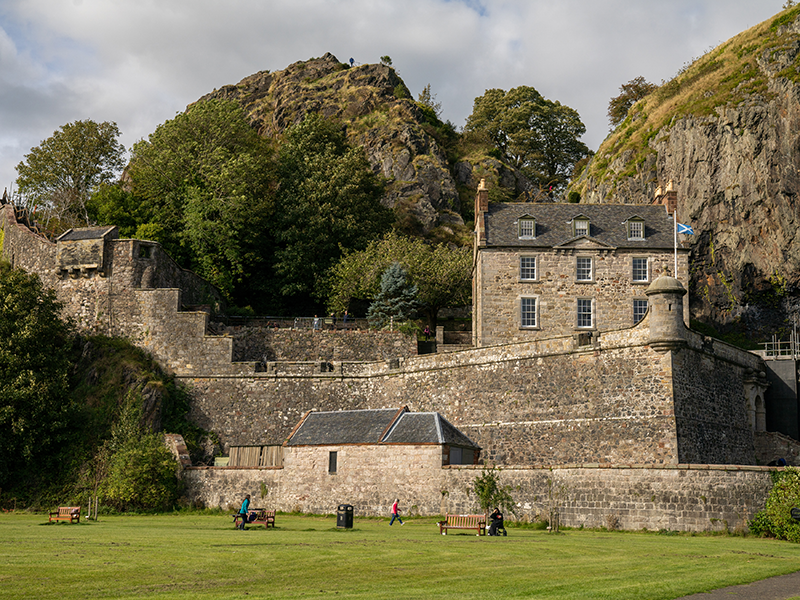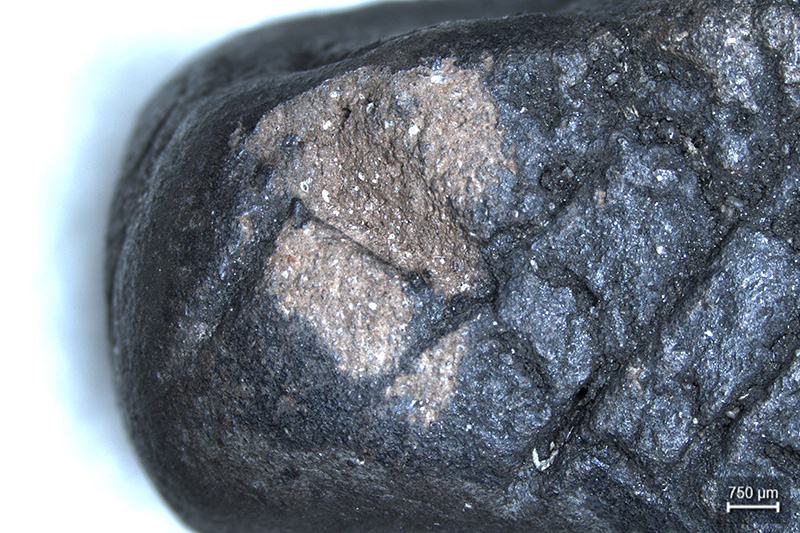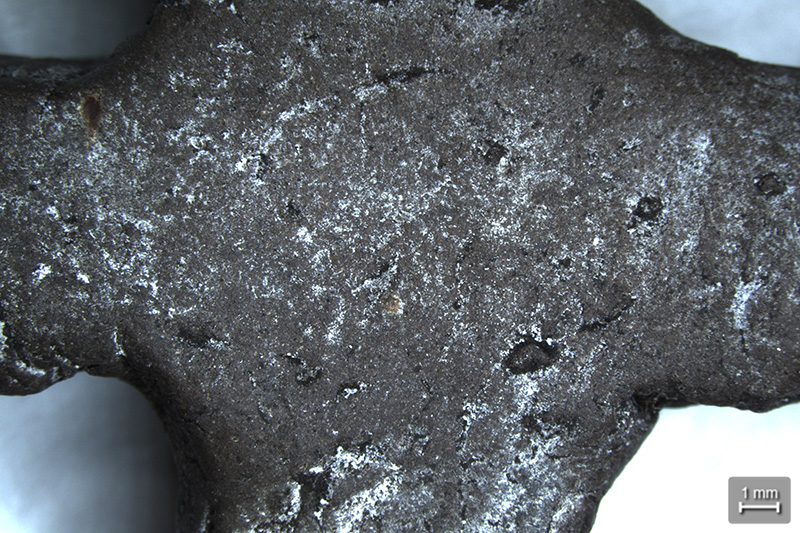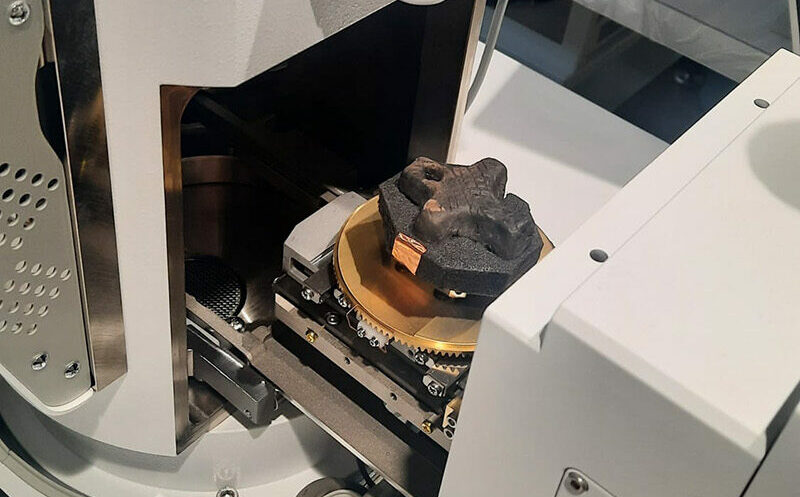Using science to understand an archaeological object: the Dumbarton Cross Pendant
Behind the Scenes, Heritage, Science | Written by: Samuel Matthews | Wednesday 9 July 2025
A small cross, found during utility works at Dumbarton Castle, is now on display in the new exhibition in the Governor’s House. However, we know very little about it. What is it made of? How was it made? How old is it?
To answer some of these questions, the cross was brought to our Heritage Science team. Using a range of techniques over a couple of days, the team was able to significantly increase our knowledge around the object, and suggest that it possibly isn’t as old as we thought. This blog will take you through the process of investigation by the team and how we use our equipment and expertise to discover more about the objects in our care.

Dumbarton Castle
What do we already know about the Dumbarton Cross?
The cross was found during utility works in the Dumbarton Castle gardens to the east of the Governor’s House in 1995. These gardens were heavily landscaped in the 18th century, so the cross has been long removed from any archaeological context that might, amongst other things, tell us how old the cross is.
Based on form, and its relatively crude nature, the cross was thought to be Early Medieval in date. This would make sense – it is thought that there was an Early Medieval Christian site where Dumbarton Castle now stands. This is evidenced by the grave slabs found nearby which you can also see on display.
Stage 1: Observations with a microscope
Before we do any advanced scientific analysis, it is important that we familiarise ourselves with any object. We do this both by simply looking at the object, and also using a microscope that allows us to observe the finer detail.
In this process, we also identify areas of interest, locations that we may want to target with further analysis. For the cross, a few such locations stood out to us.
We could see that there is a chipped area on the front left arm of the cross. While this is unfortunate from the perspective of object conservation, it is ideal for us scientists. This area allowed us to look at the material that makes up the interior, and therefore the bulk of the cross – something we otherwise wouldn’t be able to do without cutting an object open.

Detail showing the chipped section amongst the black front surface of the cross, optical microscopy.
The front surface was a black colour, and very slightly reflective when we looked at it under the microscope. This could potentially be some form of glaze applied to the cross and would be well worth targeting with our analysis.
We also noticed that the back of the cross was covered in traces of a white material. Our first thought was that it was salt, or something similar, that had crystallised on the back of the cross after it had been buried. Obviously, we needed more analysis to explore this theory!

Detail of the white material on the back of the cross, optical microscopy.
Stage 2: Portable X-Ray Fluorescence analysis
Having made our observations, it was now time to begin the more in-depth analysis. We started with portable X-Ray Fluorescence (pXRF), which can detect the elemental composition of the surface we analyse.
With pXRF, we were quickly able to confirm that the cross was a ceramic material. Furthermore, we were able to compare results from the various points of interest we identified earlier.
The black material on the front of the cross had higher calcium, sulphur, and phosphorus than the exposed section. These elements could be associated with ashes or charcoal – perhaps residue associated with the firing of the cross?
All the measurements taken on the back of the cross had elevated levels of titanium. The pXRF, however, analyses a relatively wide area, a circle around 8mm across. The white material on the back of the cross was present in sections much smaller than that, so it wasn’t possible to directly relate the two. We needed another technique!
Stage 3: Scanning Electron Microscopy
Our Scanning Electron Microscope (SEM) is a powerful instrument that lets us examine objects and materials at very high magnification. Additionally, it can determine elemental compositions at these high magnifications. For example, we can target a tiny speck of the white material specifically, rather than a large spot on the back of the cross.
Before we got there though, there were a few hurdles to overcome. At 5.5cm by 4cm, the cross is on the larger end of objects we can examine with our SEM. Additionally, because it is a whole object, we can’t stick it down to the stage with carbon tape, as we would with a powdered sample or one mounted in resin. Instead, we made a snug little foam cradle for it to sit in, so it would be held securely in place while we analysed it. Furthermore, we would usually coat SEM samples in a very thin layer of carbon or gold to make them conductive. Because the cross is an archaeological object and these coatings are difficult or impossible to remove, this isn’t possible. This means that we had to conduct our observations in a low vacuum rather than the usual full vacuum that the SEM operates under.

The Dumbarton Cross ready to go into the SEM.
Once the cross was in the SEM, we could make further observations. The exposed section looked very unconsolidated, suggesting the cross had only been lightly fired. A more strongly fired ceramic would have a glassy texture. The black surface is very smooth, with cracks throughout that suggest heating or drying. It also contains a lot of carbon, which couldn’t be detected by our pXRF, which further supports a theory of it being ash or charcoal material.
The real surprise came from the crystals on the back of the cross – these turned out to be comprised predominantly of titanium oxide. This is a common pigment used in white paint, but only in more recent times. It was first patented in the early 1800s, and only widely used once people started looking for alternatives to lead paint in the 1920s. Was our cross a modern object after all?
Whilst it was in the Engine Shed, we took the opportunity to pass the cross over to the Digital Documentation and Innovation team. They used photogrammetry, taking photos from multiple different angles and stitching those photos together, to create a 3D model of the cross. You can see the model on Sketchfab and explore the different surfaces, imperfections and the chipped area on the front.
Conclusions
The discovery of titanium based white paint on the back possibly undermines initial interpretations of an Early Medieval date for the cross. We can’t however rule out the possibility that the cross had been discovered, painted and then reburied before it was found once again more recently. Alternatively, the titanium oxide could have another, external source – from fertiliser, or from smokescreens used when Dumbarton Castle was used as a base for anti-aircraft operations in WW2.
Archaeological science can often feel like it leaves us with more questions than answers. We were able to confirm that the cross was a ceramic material, lightly fired. We were able to determine compositions of the cross fabric, the black surface on the front, and the white crystals on the back. We were able to suggest that the cross could be more modern than previously thought. But we don’t know for certain where this titanium came from – modern paint deliberately applied is just one possibility. We don’t know how the cross ended up at Dumbarton Castle to be discovered later. Our work does help deepen our understanding of objects in our care, but it is far from the end of the story of these objects – there is much more to be done!
About the author:
Samuel Matthews
Sam is an Archaeological Science Fellow, working in the Heritage Science Team at the Engine Shed. During his fellowship he has used a wide range of scientific techniques to analyse and understand archaeological objects.
View all posts by Samuel Matthews
- « Improving fire safety in traditional buildings
- Conserving windows: the rare art of stained glass conservation »
Comments are closed.



